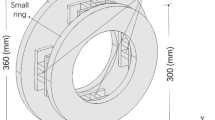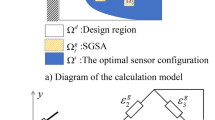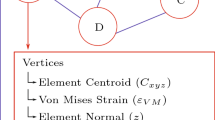Abstract
Designing force sensors with superior performance is always a challenging topic in the industry as well as in academia. This paper employs the moving morphable components method in order to design strain-gauge-based force sensors with high sensitivity and low cross-interference. The function of the Wheatstone bridge (half-bridge) is taken into account in the automatic design implementation to make it practically more feasible. Compared with our previous study on sensor design with only the high-sensitivity constraint, the further consideration of low cross-interference leads to a strict situation where the numerical iteration is hard to converge. To overcome this difficulty, three strategies are proposed, including a new description of the sensing areas, the modification of strain-gauge output constraints, and the iterative scheme with gradually shrinking bounds. Numerical examples demonstrate that these strategies perform very well and can ensure a robust iteration. Furthermore, the developed robust implementation is quite generic, which may be adopted in optimization problems with complex and strict constraints.














Similar content being viewed by others
References
Bashir R, Gupta A, Neudeck GW et al (2000) On the design of piezoresistive silicon cantilevers with stress concentration regions for scanning probe microscopy applications. J Micromech Microeng 10:483–491. https://doi.org/10.1088/0960-1317/10/4/301
Guo X, Zhang W, Zhong W (2014) Doing topology optimization explicitly and geometrically-a new moving morphable components based framework. J Appl Mech 81:081009. https://doi.org/10.1115/1.4027609
Hu XY, Bao RH, Chen WQ (2020) Enhance the sensitivity of strain-gauge-based force sensors using moving morphable units method. Struct Multidiscip Optim. https://doi.org/10.1007/s00158-020-02631-2
Kang MK, Lee S, Kim JH (2014) Shape optimization of a mechanically decoupled six-axis force/torque sensor. Sensors Actuators A Phys 209:41–51. https://doi.org/10.1016/j.sna.2014.01.001
Kazama A, Aono T, Okada R (2013) Stress relaxation mechanism with a ring-shaped beam for a piezoresistive three-axis accelerometer. J Microelectromech Syst 22:386–394. https://doi.org/10.1109/JMEMS.2012.2227139
Khaled ARA, Vafai K, Yang M et al (2003) Analysis, control and augmentation of microcantilever deflections in bio-sensing systems. Sensors Actuators B Chem 94:103–115. https://doi.org/10.1016/S0925-4005(03)00231-4
Kim S, Dong Y, Hossain MM et al (2019) Piezoresistive graphene/P(VDF-TrFE) heterostructure based highly sensitive and flexible pressure sensor. ACS Appl Mater Interfaces 11:16006–16017. https://doi.org/10.1021/acsami.9b01964
Li X, He H, Ma H (2019) Structure design of six-component strain-gauge-based transducer for minimum cross-interference via hybrid optimization methods. Struct Multidiscip Optim 60:301–314. https://doi.org/10.1007/s00158-018-2177-y
Rubio WM, Silva ECN, Nishiwaki S (2008) Piezoresistive sensor design using topology optimization. Struct Multidiscip Optim 36:571–583. https://doi.org/10.1007/s00158-007-0191-6
Svanberg K (1987) The method of moving asymptotes-a new method for structural optimization. Int J Numer Methods Eng 24:359–373
Takezawa A, Nishiwaki S, Kitamura M, Silva ECN (2010) Topology optimization for designing strain-gauge load cells. Struct Multidiscip Optim 42:387–402. https://doi.org/10.1007/s00158-010-0491-0
Tewari A, Gandla S, Bohm S et al (2018) Highly exfoliated MWNT-rGO ink-wrapped polyurethane foam for piezoresistive pressure sensor applications. ACS Appl Mater Interfaces 10:5185–5195. https://doi.org/10.1021/acsami.7b15252
Widrow B, Lehr MA (1990) 30 years of adaptive neural networks: perceptron, madaline, and backpropagation. Proc IEEE 78:1415–1442. https://doi.org/10.1109/5.58323
Xia Q, Shi T, Liu S, Wang MY (2013a) Shape and topology optimization for tailoring stress in a local region to enhance performance of piezoresistive sensors. Comput Struct 114–115:98–105. https://doi.org/10.1016/j.compstruc.2012.10.020
Xia Q, Shi T, Liu S, Wang MY (2013b) Optimization of stresses in a local region for the maximization of sensitivity and minimization of cross - sensitivity of piezoresistive sensors. Struct Multidiscip Optim 48:927–938. https://doi.org/10.1007/s00158-013-0997-3
Yan C, Wang J, Kang W et al (2014) Highly stretchable piezoresistive graphene-nanocellulose nanopaper for strain sensors. Adv Mater 26:2022–2027. https://doi.org/10.1002/adma.201304742
Yang SM, Yin TI (2007) Design and analysis of piezoresistive microcantilever for surface stress measurement in biochemical sensor. Sensors Actuators B Chem 120:736–744. https://doi.org/10.1016/j.snb.2006.03.053
Yang M, Zhang X, Vafai K, Ozkan CS (2003) High sensitivity piezoresistive cantilever design and optimization for analyte-receptor binding. J Micromech Microeng 13:864–872. https://doi.org/10.1088/0960-1317/13/6/309
Zhang W, Yuan J, Zhang J, Guo X (2016) A new topology optimization approach based on moving morphable components (MMC) and the ersatz material model. Struct Multidiscip Optim 53:1243–1260. https://doi.org/10.1007/s00158-015-1372-3
Zhang S, Liu H, Yang S et al (2019) Ultrasensitive and highly compressible piezoresistive sensor based on polyurethane sponge coated with a cracked cellulose nanofibril/silver nanowire layer. ACS Appl Mater Interfaces 11:10922–10932. https://doi.org/10.1021/acsami.9b00900
Zhu M, Inomata N, Adachi N et al (2019) High-gauge factor strain sensor based on piezoelectric aluminum nitride coupled to MOSFET. IEEE Sensors J 19:3626–3632. https://doi.org/10.1109/JSEN.2019.2895267
Zienkiewicz OC, Taylor RL, Nithiarasu P et al (1977) The finite element method. McGraw-hill, London
Funding
The work was supported by the National Natural Science Foundation of China (Nos. 11621062 and 11872329).
Author information
Authors and Affiliations
Corresponding author
Ethics declarations
Conflict of interest
The authors declare that they have no conflict of interest.
Replication of results
All the results in this paper are generated using our homemade MATLAB codes. The source codes can be available from the corresponding author with reasonable requests.
Additional information
Responsible Editor: Xu Guo
Publisher's note
Springer Nature remains neutral with regard to jurisdictional claims in published maps and institutional affiliations.
Appendices
Appendix 1. Effects of initial parameters on optimization
Four different adjacent-bridge cases (with Rdt = 0.02) are considered here to show the effects of the initial parameters. Case A is the same as that shown in Fig. 8a, with an initially symmetric distribution of the SAs with respect to y = 0.5. Case B has a different initial location pattern of the SAs. The indexes of Case A and Case B show that the current calculation framework is very robust when handling the different initial locations of SAs. Case C and Case D compare the results for different numbers of the moving morphable components. Case C has 3 × 3 × 2 components while Case D has 5 × 5 × 2 components. The indexes of Case C and Case D agree well with those of Case A, which again clarifies the robustness of the proposed calculation framework.
However, the local structures around the SAs are totally different for different cases. The reason is that the formulation prefers to have the stress concentration regions around the SAs to enhance the sensitivity. Due to the rapidly decaying characteristic of stress concentration, only a small number of elements within the SAs are endowed with a high compliance and the increase of the compliance in those elements does not lead to a sharp increase in the global compliance. Thus, although the local structures are different, the constraints can be satisfied quite well with little difference in the value of the objective function. In this regard, there might exist many local optima near the global optimum which cannot be distinguished clearly by the current optimization algorithm. It is noted that a small number of components might be insufficient to construct the local structure (see the optimal configuration in Case C) since the SAs will be the main load-bearing structures, which can make the optimal configuration unusable. Hence, it is necessary to assume a large number of components in the initial state in practice.
Appendix 2. Effect of the bridges
The introduction of bridges around the SAs is one of the main modifications adopted in the present TDF for the SAs, as compared to our previous work (Hu et al. 2020). Here, we investigate the effectiveness of the modified scheme by comparing the numerical results between the cases with and without bridges. For this purpose, Case C in Appendix 1 is considered. Figure 16 displays the corresponding iteration paths and the optimal configurations for the two cases (with and without bridges). It is seen that the absence of bridges leads to a weak connection between the SAs and the main structure, which obviously aggravates the instability of the iteration procedure.
Appendix 3. MMA coefficients
The MMA parameters \( {u}_j^{(h)} \) and \( {l}_j^{(h)} \) are controlled through their upper and lower bounds in the following way
where \( \left\{{l}_{\mathrm{min}}^{(h)},{l}_{\mathrm{max}}^{(h)},{u}_{\mathrm{min}}^{(h)},{u}_{\mathrm{max}}^{(h)}\right\} \) are the bounds of the MMA parameters at the h‐th step of iteration and \( {D}_j^{(h)} \) is the current value of the design variable at the h‐th step of iteration with its upper and lower bounds \( {\overline{D}}_j \) and \( {\underline{D}}_j \). For details of the asymptotic expansion, the reader is referred to the paper of Svanberg (1987). Empirically, small values of the two coefficients \( {C}_1^{ma} \) and \( {C}_2^{ma} \) lead to a stable iteration procedure. If the iteration path cannot approach the current bounds within Nm steps, these two coefficients will be reduced by half. On the contrary, they will be increased by 50% when the bounds are updated in this study. In our calculations, the initial values of these two coefficients are set as \( {C}_1^{ma}=10 \) and \( {C}_2^{ma}=1 \).
Rights and permissions
About this article
Cite this article
Hu, X., Bao, R., Chen, W. et al. Robust optimal design of strain-gauge-based force sensors using moving morphable components method: enhanced sensitivity and reduced cross-interference. Struct Multidisc Optim 64, 1439–1455 (2021). https://doi.org/10.1007/s00158-021-02929-9
Received:
Revised:
Accepted:
Published:
Issue Date:
DOI: https://doi.org/10.1007/s00158-021-02929-9






